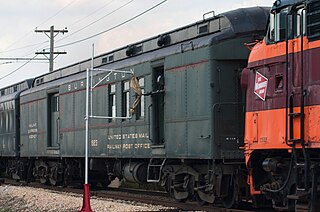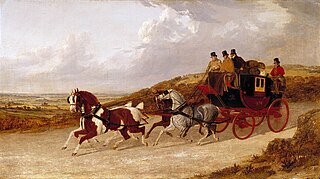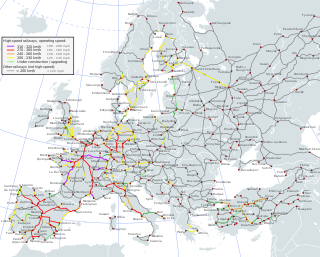The present disambiguation page holds the title of a primary topic , and an article needs to be written about it. It is believed to qualify as a broad-concept article . It may be written directly at this page or drafted elsewhere and then moved over here. Related titles should be described in Mail train, while unrelated titles should be moved to Mail train (disambiguation) . |
Many countries have had dedicated railway services for the delivery of postal mail.

The mail or post is a system for physically transporting postcards, letters, and parcels. A postal service can be private or public, though many governments place restrictions on private systems. Since the mid-19th century, national postal systems have generally been established as government monopolies, with a fee on the article prepaid. Proof of payment is often in the form of adhesive postage stamps, but postage meters are also used for bulk mailing. Modern private postal systems are typically distinguished from national postal agencies by the names "courier" or "delivery service".
Examples include:
- In Australia, the Travelling post office, Queensland

A Travelling Post Office (TPO) is a postal receiving, sorting and delivery service situated on a train, usually in a specially designated carriage that is part of a passenger train. In Queensland, Australia, the service was provided from 1877 to 1932.
- In Austria, the Bahnpost (Austria) (1850–2004)
- In France, the SNCF TGV La Poste (1984–2015) were rail cars built specifically for La Poste, which had run rail services since 1846
- In Germany, as well as the Bahnpost (Germany) (from 1840s), several cities have their own mail trains, including:
- Poststraßenbahn Berlin in Berlin
- Post-U-Bahn München in Munich
- In Switzerland, the Bahnpost (Switzerland) has run since 1847
- In the United Kingdom, the Travelling Post Office (1830–2004) was a service where post was sorted en route
- The London Post Office Railway (1927–2003) operated in dedicated tunnels under London
- In the United States, the Railway Mail Service (1862–1978) of the United States Postal Service carried the vast majority of mail from the 1890s until the 1960s
- The Railway Mail Service used railway post offices within passenger services to sort post en route
- The use of the Chicago Tunnel Company for mail freight inspired the London Post Office Railway

In the United States, a railway post office, commonly abbreviated as RPO, was a railroad car that was normally operated in passenger service as a means to sort mail en route, in order to speed delivery. The RPO was staffed by highly trained Railway Mail Service postal clerks, and was off-limits to the passengers on the train. In the UK and Ireland, the equivalent term was Travelling Post Office (TPO).

The Chicago Tunnel Company built a 2 ft narrow-gauge railway freight tunnel network under the downtown of the city of Chicago. This was regulated by the Interstate Commerce Commission as an interurban even though it operated entirely under central Chicago, did not carry passengers, and was entirely underground. It inspired the construction of the London Post Office Railway.

The TGV La Poste were dedicated trainsets for high-speed freight and mail transportation by French railway company SNCF on behalf of the French postal carrier La Poste. The top speed of this TGV Sud-Est derivate was 270 km/h (168 mph), making them the fastest freight trains in the world. They were withdrawn in 2015.

A Travelling Post Office (TPO) was a type of mail train used in Great Britain and Ireland where the post was sorted en route. The last Travelling Post Office services were ended on 9 January 2004, with the carriages used now sold for scrap or to preservation societies.

The Post Office Railway, known as Mail Rail since 1987, is a 2 ft narrow gauge, driverless underground railway in London that was built by the Post Office with assistance from the Underground Electric Railways Company of London, to move mail between sorting offices. Inspired by the Chicago Tunnel Company, it operated from 1927 until 2003. A museum within the former railway was opened in September 2017.
| This article includes a list of related items that share the same name (or similar names). If an internal link incorrectly led you here, you may wish to change the link to point directly to the intended article. |








